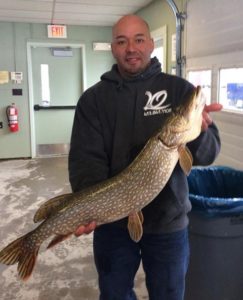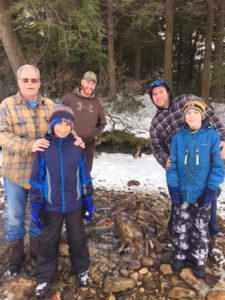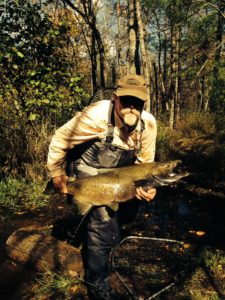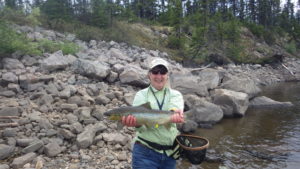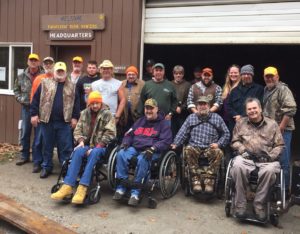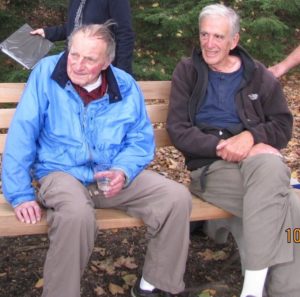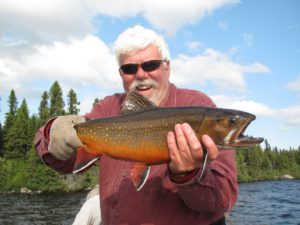Sometimes you might hook onto weird stuff while ice fishing such an old boot or something from the bottom of the lake. Why, just a week or so ago, a buddy of mine pulled in a beer can. Somehow, his fishing line and hook wrapped around it. Hmmm, wonder how that happened.
Sunday, February 4 was a nice sunny day and Cory Walton of Hinsdale was out with his buddies ice fishing on Plunkett Lake in Hinsdale, MA. They had set up about 25 yards from the shoreline. Around 9:30 AM they saw a critter resembling a weasel along the shoreline near where some ice had buckled up. They didn’t pay too much attention to it, and were just enjoying the day.
Around 1:00 PM, Cory’s tip-up flag went up and he went to attend to it. As he was approaching it, he could see the tip-up shaking in the hole, a good indication that a sizeable fish was on the end of the line. When he got to the hole and checked his tip-up, he saw that all of the line was stripped from the reel, except where the line was tied to it. He set the hook and started hauling in the fish. Whatever was on the end of his line under the ice didn’t fight like a fish, but it was moving. When he started to pull it through the hole, he was shocked to see an angry river otter. Cory got it half way out of the hole, but it braced itself on the ice with its two front legs and refused to be pulled out of the hole.
The guys were all surprised and started hooting and yelling. The otter made a fierce spin, shook the hook and slipped back into the hole. After it got loose, the guys checked all around the hole for blood to see if it had been hurt. Fortunately, there was no signs of blood or other bodily damages.
Cory said that there was no open water anywhere for the otter to get into the lake and under the ice except for that buckled ice near the shoreline. Between that area and his tip-up there was no open water. Somehow it got into the water, swam under the ice to his live bait and took it. Presumably it had swum up from the Housatonic River in the Hinsdale Flats area, up Frissel Brook and into Plunkett Lake.
Well, fishermen have been known to stretch the truth a tad and I was a little skeptical after hearing this fishy story. It certainly was a classic requiring some imagination. Well, the skepticism disappeared when I actually saw a video of the event which was posted on Facebook by Cory’s buddy Justin Russell. Nope, this was definitely not fake news. Hmmm, I wonder if there is a State freshwater fishing award for otters.
The 32nd annual Jimmy Fund Ice Fishing Derby, which was held on Sunday, February 11 at Onota Lake was another success. In spite of the rainy weather, a nice crowd participated. The winners were:
Kids 12+ under
Caesen Kendall, 3.9 lbs Brown Trout
Dominic Curtin, 3 lbs Pickerel*
Miranda Dygun, 1.2 lbs Pickerel
*It’s interesting that Dominic Curtin’s mother, Eden Curtin, won this event when she was a child. According to Steve Bateman, she won it in 1995 or 1996 by catching a large Atlantic salmon. Its nice to see such traditions being passed on from generation to generation.
Young Adult 13-17
Rick Armstrong, 3.2 lbs Pickerel
Ben Mancini, 1.4 lbs Pickerel
Colby Gray 1.0 Lbs Brown Trout
Adults 18+
Eric Moser, 8.8 lbs Pike
Todd Wich, 6.2 lbs Pike
Ralph Wendling 5.0 lbs Pike
Congratulations to all.
The 13th annual Tom Wren Memorial Ice Fishing Derby will be held on Saturday February 24 from 6AM to 3 PM on Pontoosuc Lake in Pittsfield. Sign- ins will be in the marked gray camper shanty just on the ice off the public right away at Narragansett Park in Lanesboro. The gray camper shanty will have a big banner marking it. The cost is: Adults – $10 and children – $5. All cash brought in will be paid out in prizes. Prizes will be awarded for the top three heaviest fish in both adult and children’s categories. Final weigh is at 3 PM at the sign-in station. Participants are asked to please bring a big pail or something to transport the fish to weigh-in and ensure a healthy release.
Firearms safety course
A live fire NRA & Massachusetts State Police Certified Firearms Safety Course will be held on Saturday February 24th at the Cheshire Rod & Gun Club in Cheshire, MA. This is to qualify MA residents and non- residents alike for the MA License -To- Carry or FID Card. This will be a hands-on live firing, one day course. A full lunch will be provided and a $10 gift certificate to Pete’s Gun Shop. The cost is $100 which covers all ammo, safety gear, class materials, certificates, a hardcover NRA textbook and food. It runs from 9AM to about 4:30PM. Be there by 8:45 AM to sign in. Interested parties are asked to pre-register by calling or stopping in at Pete’s Gun Shop at 413-743-0780.
The Massachusetts LTC is now recognized for concealed carry in 29 states including:
Arizona, Alaska, Alabama, Arkansas, Idaho, Iowa, Indiana, Kansas, Kentucky, Maine, Massachusetts, Michigan, Missouri, Mississippi, Montana, New Hampshire, Nevada, North Carolina, North Dakota, Ohio, Oklahoma, South Dakota, Tennessee, Texas, Utah, Vermont, Virginia, West Virginia, and Wisconsin.
This list is constantly being added to. Check with Pete’s periodically for new additions. Residents of Vermont can get the MA Non-Resident LTC by taking this course, and if National Reciprocity passes they can then take advantage of it.
Rocky Mountain Elk Foundation Banquet
The Bay State Chapter of the Rocky Mountain Elk Foundation is having a banquet on Saturday, February 24 at the Stockbridge Sportsmen’s Club. Even if you don’t hunt elk, it is a social evening of fun, great food and camaraderie all for the benefit of elk country. Peter DelGrande’s famous Herb-crusted Boneless Prime Rib and Chicken Marsala Buffet is reason enough to attend.
Prizes include incredible firearms and bows, premium hunts, trips and adventures, limited edition art, handcrafted pottery and home furnishings, custom jewelry, and much more. Tickets are limited, and cost: Single Attendee – Includes 1 Meal & 1 Supporting Membership – $70.00, Couple Attendee – Includes 2 Meals & 1 Supporting Membership – $105.00. Doors open at 5:00pm. Call Gary D. Johnston at (413) 298-3623 for more information.
The 35th Annual Springfield Sportsmen’s Show
The show take place at the Eastern States Exposition (Big E) 1305 Memorial Ave., West Springfield, MA) on February 23 through 25. The show includes the best of hunting, fishing, boating and adventure recreation. The show hours are Friday from noon to 8 PM, Saturday 9 AM to 7 PM and Sunday 10 AM to 5 PM. Admission: Adults – $14, kids 6 to 12 $5 and under 6 Free.
The aisles will be filled with everything you need to enhance your sportsmen’s lifestyle. From all new hunting and fishing gear to special items like trip packages to exotic destinations
World renowned big game hunter and TV star, Dick Scorzafava will present his well-known Radical Hunting Success Seminar, sign books for his many fans and give away thousands of dollars worth of hunting gear in Dick’s Big Gear Giveaway.
Kids will see all of Bwana Jim’s favorite critters in person from alligators to snakes. In this entertaining and educational program, Bwana Jim will introduce you to an extensive array of animals and teach you all about how they live in the wild
David Pickering, the “Carp King,” is the go to expert when it comes to carp fishing. In his seminar, “Targeting Large Carp,” Dave will discuss strategies and various topics related to fishing for trophy carp.
Cory de Sousa was chosen by Tom Miranda to join the Elite Pro Staff of Mathew’s Dominant Bucks TV. His hunts have been filmed and they can be seen on Mathew’s Dominant Bucks TV as well as on Whitetail Slam TV. He is being recognized for his many years of experience and impressive success in the woods.
Paul Sannicandro of Moose Woods Guide Service will explain the principles of compass navigation. In addition, Paul will cover the importance of understanding the difference between magnetic north and true north as well as explaining the process of setting the declination for your compass.
Joe Judd, will be presenting a turkey hunting seminar. Joe is an award-winning turkey caller who has over 35 years of hunting experience to his credit. This highly regarded expert is a member of the Quaker Boy Pro Staff and he is also a member of the hunting Pro Staff for Alpen Optics. In 2013, Joe was the recipient of the prestigious Roger Latham Award presented by the National Wild Turkey Federation. A National Honor, this is the highest commendation given to a volunteer member by the NWTF.
Representatives from the U.S. Department of Veterans Affairs will be at the show to meet with military veterans and their family members to assist them with connecting with VA benefits. Eligible Veterans can sign up for VA health care at the show.
The Big Buck Display which is put on by the Northeast Big Buck Club will be there. The Big Buck Club is a non-profit organization dedicated to Northeast hunters and outdoorsmen. Each year, hundreds of volunteers measure trophy bucks from MA, CT, VT, RI, ME, NH, NY and PA.
There is so much more to see at the show.

